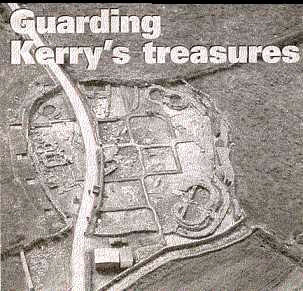| Guarding Kerry's
treasures
Excavations of Reask site a mile east of Ballyferriter, in 1972. The Council built a new road to replace the one dividing the ecclesiastical site. Historic building must be protected, before it is to late. The proposed record of protected structures being compiled by Kerry County Council in accordance with the Planning & Development Act 1999 is a mammoth task. The list is an ongoing one and will be added to, until such time as it is very comprehensive. Already 485 buildings have been selected to be included in the list, but only one building in the county- Ballymacelligott Creamery is already a protected structure, by order of the County Council. There are hardly any convents in the list and Presentation Convent in Castleisland would be worthy of preserving, a fine example of cut stone workmanship at a time when stone cutting was a labour associated with Tralee Jail and other places of detention. The significance of a protected building includes: architectural, historical, archaeological, artistic, cultural, scientific, social or Technical aspects.
|

photo: Padraig kennely, The Kerry's Eye June 2001
|



